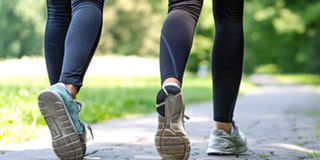Walking might be all you need

Walking is one of the most under looked physical exercises yet, if done well has tremendous health benefits, such as reduced risk of heart disease, excess weight and obesity, type 2 diabetes, depression and anxiety, osteoporosis and many cancers.
Many fitness buffs, according to Abrahuman Sulaiman a.k.a coach Nash prefer other vigorous exercises to walking because its benefits still remain largely concealed.
“Contrary to popular belief, walking as a way of exercising is not just for expecting mothers or senior citizens. The problem is largely compounded by us (fitness trainers) because we are interested in faster results in a short amount of time. Walking at a moderate pace is a good enough and cheap exercise that can be done by individuals with varying levels of health and fitness,” he notes.
Remmy Semwaka, a fitness trainer says he often recommends walking for clients whose bodies need a gentler yet effective form of exercise before starting other high intensity exercise regimens.
“I usually instruct them to start slow (5 km/hour) for about 10 minutes at a time. The pace and duration keeps getting higher as the person’s body begins to adapt and gain strength and balance,” he says.
Walking technique
Both coaches agree that for good results the individual needs to learn how to walk properly.
“Walking is not just a matter of putting one foot in front of another, you need proper technique and posture,” coach Nash opines.
Walk with your head raised looking forward. Your neck shoulders and back should be relaxed, and arms able to swing freely with a slight bend in your elbows. Tighten your stomach muscles and walk smoothly, rolling your foot from heel to toe.
Plan your route
According to Semwaka, where you walk should be guided by how fit you are. Start with a flat route for the first 10 minutes to give the body enough time to warm up. After a brief rest, you can choose to continue or move to a slightly raised plane that will give your body some more challenge.
“You must always put your safety first when planning your route. Choose routes that have less traffic, have no dark corners or gaping holes,” he cautions.
Walking outfit
Coach Nash recommends comfortable clothes that will enable freedom of movement and protect you from other road user such as bright colors or reflective tape for visibility. The right shoes give you the correct balance and posture during the walk while poorly fitted walking shoes can cause pain or increase susceptibility to injury. Choose shoes with proper arch support, a firm heel and thick flexible soles.
Stay focused
Remember it is advisable to start slowly, especially if you have not been exercising regularly. As a general goal, aim for at least 30 minutes of physical activity a day. Any amount of activity is better than none at all. Even small amounts of physical activity are helpful, and accumulated activity throughout the day adds up to provide health benefit.




